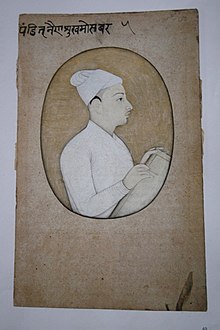Nainsukh | |
|---|---|
 Self-Portrait at the age of 20 | |
| Born | Nainsukh c. 1710 |
| Died | 1778 Guler, Guler State |
| Known for | Painting |
| Movement | Pahari painting |
| Family | Manaku (brother) |



Nainsukh (literally "Joy of the Eyes"; c. 1710[1] – 1778) was an Indian painter. He was the younger son of the painter Pandit Seu and, like his older brother Manaku of Guler, was an important practitioner of Pahari painting, and has been called "one of the most original and brilliant of Indian painters".[2]
Around 1740 he left the family workshop in Guler and moved to Jasrota, where he painted most of his works for the local Rajput ruler Mian Zorowar Singh and his son Balwant Singh until the latter's death in 1763. This is the best known and documented phase of his career. Through his adaptation of elements of Mughal painting, he was a central force in the development of Pahari painting in the middle of the eighteenth century, bringing Mughal elements into what had been a school mainly concerned with Hindu religious subjects.[3] In his final phase at Basholi, from about 1765 until his death in 1778, Nainsukh returned to religious subject matter, but retaining his stylistic innovations. By the end of his career, with an active family workshop continuing his style, he was probably not executing the works himself anymore, but leaving them to his children and nephew as his artistic heirs. Such works are often ascribed to the Family of Nainsukh.[4]
According to B.N. Goswamy, the leading scholar of Nainsukh, "Devices and mannerisms associated with Nainsukh include: a preference for uncoloured grounds; shading through a light wash that imparts volume and weight to figures and groups; a fine horizontal line that separates ground from background; a rich green in which his landscapes are usually bathed; a bush with flat circular leaves that he often introduces; a peculiar loop of the long stem of a hooka; and a minor figure often introduced in a two-thirds profile."[5]
Although a great part of his work may be lost, around a hundred works by Nainsukh survive, many in both Indian and Western museums. Four of these bear his signature, and several have inscribed titles or comments.[6] Unusually for Pahari painting, some are dated.[7] There are at least two self-portraits, one from early in his career, and the other in a group scene with Balwant Singh, who is looking at a miniature, with the artist seated below him. Nainsukh peers over the raja's shoulder, perhaps offering his comments on the work, or ready to do so.[8]'
Nainsukh, a film based on his life directed by Amit Dutta released in 2010. Dutta has also made the short documentary films Gita Govinda (2013), Field-Trip (2013), and Scenes from a Sketchbook (2016) which cover different aspects of the painter's work.[9]
- ^ Crill and Jariwala, 140 say "c. 1710–20" on the birth date, see also Pahari-Meister, p. 268.
- ^ Kossak, 99
- ^ Grove; Guy, 160; Harle, 411-12
- ^ Beach, 199–200
- ^ Grove
- ^ A list of his works in B.N. Goswamy, Eberhard Fischer: Nainsukh of Guler. In: Milo C. Beach, Eberhard Fischer, B.N. Goswamy (Hrsg.): Masters of Indian Painting. Artibus Asiae Publishers, Zürich 2011, Vol. 2, 689–694.
- ^ Harle, 411
- ^ The latter painting (Museum Reitberg, Zürich) was exhibited in two recent exhibitions: #43 in London, Crill and Jariwala, 140–141, and # 83 in New York, Guy, 162; a detail of the earlier is shown at Guy, 160
- ^ "Scenes from a Sketchbook | Amit Dutta's Cinematic Museum". watch.eventive.org. Retrieved 30 May 2021.